It was buried by a volcanic eruption in 79 A.D. Pompeii. When the ruins came to light, beginning in 1747, they caused a revolution in taste- stripping away rococo gilt, reshaping the female figure , and leaving a deposit of pseudo-Greek temples from Moscow to Mississippi-although what sometimes passed for “classical” would have bewildered the ancients…
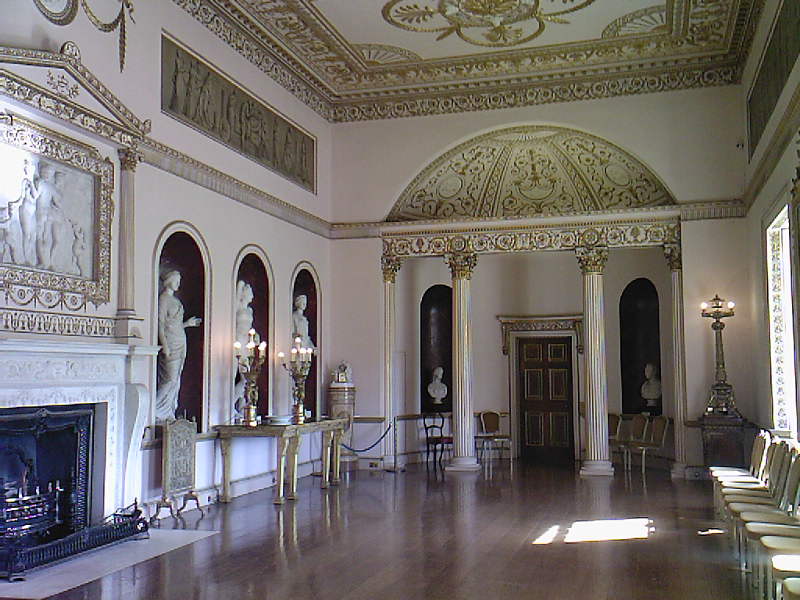
A relief of the Three Graces, based on a Pompeiin fresco, adorns a marble mantelpiece in Syon House near London. The Duke of Northumberland had instructed Robert Adam to design a house in the antique style. "The idea was to me a favorite one, the bubject great," wrote Adam, adding enthusiastically, "and the expense unlimited."
…With such influential patrons as Sir William Hamilton, Plenipotentiary of Naples ( 1764-1800 ) and wife Emma Hamilton and her “Grecian Attitudes” and more provocative Grecian eurythmics as they came to be called, Pompeii and Herculaneum were bound to prosper. Sir William was the foremost connoisseur of his time, and he drew shoals of visitors; Emma, once George Romney’s model, was equally at home with artists and the artistic world; and with Johann Winckelmann and Goethe to give the final seal of artistic approval, Naples soon hummed with artistic activity.
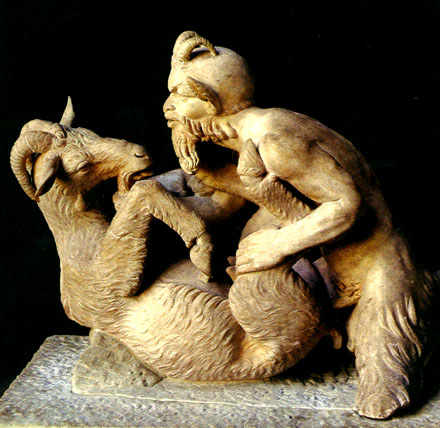
"--The statue had stood, a garden party background prank, along the flank of the elongated pool in the Great Peristyle of what we call today the Villa of the Papyri. The educated among the observers when it was first brought to light would have recognized in this garden sculpture from antiquity nothing more than an amusing allegory. The lover copulating with the she-goat was Pan, forest god and the Arcadian protector of flocks and shepherds. Denizen of woodlands, Pan notoriously startled people out walking in a wood (his surprising them gave us the word “panic”).---"
No artist could afford to miss a year or so there. Before the reign of George III, artists had studied the antique and the Renaissance with equal zest. But when Academy students were sent to Italy in the 1750’s, they were instructed to concentrate on glorious antique. The moderns had become anathema to all: Winckelmann had written that “imitation of the Ancients is the shortest way to perfection in the fine arts,” and clearly those painters who nearly resembled them would be the best.
With each passing year the attraction of Pompeii and nearby Herculaneum grew stronger. There were constant new surprises, and the continual hope, rarely disappointed, of more to come. Such progress kept the discoveries in the news. The changing pattern revealed by the excavations meant that the spectacle never staled, and each fresh find added to the tourist appeal. There was always the hope of witnessing some momentous discovery and always the likelihood of seeing things unknown to the world the previous year. And finds of such astonishing richness as Karl Weber’s discovery of a great peristyle in 1750 could be counted on to send interest soaring to new heights. Classicism had become “le dernier cri.”

Met:The sculptor John Flaxman (1755–1826) designed a large body of work for production by Wedgwood, including this cylindrical vase in the form of a miniature ancient Roman household altar made of blue jasper with white decoration in relief. The sides are divided by pilasters into six panels containing figures of the Muses Thalia, Urania, and Erato, alternating with pendant trophies with attributes of Jupiter, Mars, and Mercury (thunderbolt, spear and helmet, caduceus). Source: John Flaxman; Made by Josiah Wedgewood and Sons: Vase (09.194.7) | Heilbrunn Timeline of Art History
“Servants rushed ahead to prepare a picnic and raise an improvised canopy tent alongside the entry to the tunnel being excavated by Swiss army engineer Karl Weber and his small crew of convict laborers. Then the entire court converged to see what was being hoisted to the surface. A court artist stood by, ready to capture the first impressions for the painting he would complete in his studio.
Amidst a flotilla of courtiers in silks and befurred velvet finery, Charles and his Prussian wife Queen Maria Amalia arrived in a rustling, stately procession and took their seats on folding chairs. From the bowels of the earth the carved white marble group of two embracing figures, which Weber had found in the Great Peristyle, appeared at the mouth of the tunnel, borne upon a litter. A shiver of excitement rippled through the court. Already the dainty turn of that horn revealed the prized Greek look. When the whole sculpture group hoved into view two heads could be seen and two bodies. One seemed to be a man of sorts, though at closer look he wore two small horns on his head. He gazed fondly into the female’s languid marble eyes. For locked in his embrace was a female goat, surely the prettiest in the flock, whom he was in the act of penetrating.” ( Judith Harris )
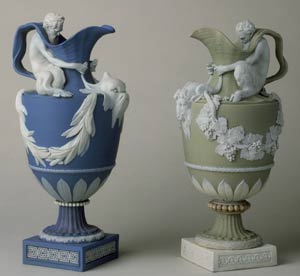
"The 1760s saw a major change in taste. The publication of archaeological discoveries like those at Pompeii and Herculaneum was revealing to excited Georgian eyes the reality of Roman and Greek art. Architects like Robert Adam were cleverly adapting the style for everything from palaces down to knife-boxes. This design movement is nowadays known as Neoclassicism. From the commercial point of view, it meant that there was a ready market for decorative objects that would suit fashionable rooms of this kind. Wedgwood was one of several manufacturers who saw an opening for new types of product. Matthew Boulton's work in gilt bronze, Eleanor Coade's artificial stone, and the porcelain of Derby were all competitors in different ways."
No one was quicker to exploit this new demand and no one did more to further the classical fashion, than Josiah Wedgwood. He changed his style and became the prophet of the new art form. It was to this realization of the possibilities of neoclassicism- while his rivals still busied themselves with what he called “a dazzling profusion of riches and ornament” – that Wedgwood owed much of his success. He had first use of a market ̶
ndy for antique.” He did everything he could to promote and serve the new fashion.Wedgwood based his vases on the urns amphorae of the ancients; he decorated them with classical swags and garlands; he reproduced their cameo medallions and reclining figures. He invented new glazes to suit their designs and revived encaustic painting to decorate them. He named his new factory “Etruria” and inscribed on its first products the words “Artes Etruriae Renascuntur”- The Arts of Etrurua are Reborn- . He was, of course, like everyone else, mistaken in thinking that Pompeii and Herculaneum were Etruscan; but mistaken or not, his loyalty to the antique was unswerving.
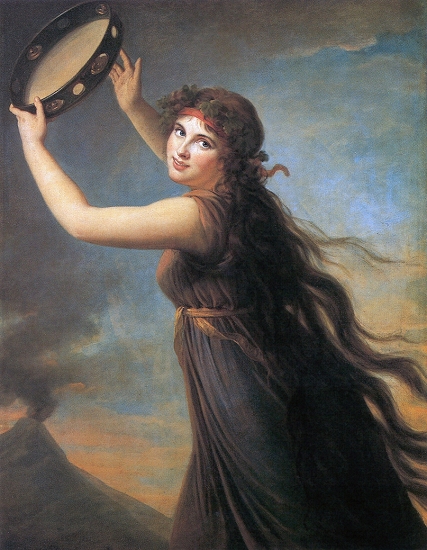
Goethe: ( Sir William Hamilton) ...has had a Grecian costume made for her that suits her to perfection, and she lets down her hair, takes a few shawls, and varies her postures, gestures, expressions, etc., until at last the onlooker really thinks he is dreaming. In her movements and surprising variety one sees perfected what so many thousands of artists would have liked to achieve. Standing, kneeling, sitting, lying, grave, sad, roguish, wanton, penitent, enticing, menacing, fearful, etc.., one follows upon the other and from the other. She knows how to choose and change the folds of her veil to set off each expression, and makes herself a hundred different headdresses with the same cloths.
In only one way was he unfaithful to his classical models: when English society found the uncompromisingly naked figures of the ancients “too warm” for its taste, and the ardor of the Greek gods too easily apparent, Wedgwood was quick to cloak their pagan immodestly- gowns for the girls, and fig leaves for the gods was the usual arrangement. But as he once had to remind one of his artists, John Flaxman, “Fig leaves are not always enough,” and in these cases the figures were completely redraped.
Although this often corrupted the original source-Priapus for instance, was so draped and beflowered in Wedgwood’s version as to conceal his purpose in life- it did little to harm his popularity. Such was his success that his rivals were forced to follow suit and imitate his designs. Not only the humble Staffordshire potters, who were used to basing their policy on the dictates of his fertile genius, but the great Continental factories of Sevres, Meissen, Frankenthal, Docia, Vienna, Paris, and Furstenberg all had to follow his lead and reproduce Wedgwood designs. Where once rococo whimsey had run riot, now antique severity reigned.
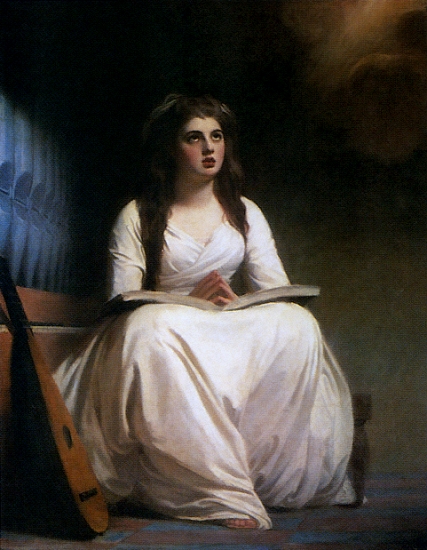
George Romney portrait. JudgementofParis.com:Emma merited her reputation as a "living work of art" not only by virtue of her Classical beauty, but also because she devised a unique form of performance art, one involving brief scenes of acting and dancing, which became famous throughout Europe as "Lady Hamilton's Attitudes." The Victoria & Albert Museum, which possesses contemporary sketches depicting Emma's "Attitudes," describes these performances as a series of theatrical mimes and poses in which she represented various figures from classical literature, myth and history . . . While performing her 'attitudes', Emma created a living gallery of statues and paintings by clever manipulation of her long shawl, her pose and facial expression, and the use of props, such as a vase. She acted a succession of characters, for example from a Roman maiden making an offering, to a devotional saint, to the classical figure Medea slaying her child. The audiences - connoisseurs and Grand Tourists - for whom Emma performed her poses, would all have recognised the various characters familiar to them in the form of classical sculptures and in depictions in Old Master paintings. Her audiences were profoundly impressed both by how she seemed able to bring to life the characters shown in famous works of art and the emotional intensity she conveyed in a performance.
ADDENDUM:
Weber owns the reputation, among the relatively few who know his name and work, of being the first semi-professional archaeologist to operate near Vesuvius.
What exactly accounts for that reputation? At a time when the excavator was totally the servant of a monarch and his court officials, instructed to bring to the surface as swiftly and ruthlessly as possible antique finds that would enhance the private art collection of the prince or king, and to ignore or even destroy anything ordinary, Weber showed curiosity about the contexts from which the beautiful finds were wrenched and tried to explore the urban culture of the buried cities of Herculaneum and Pompeii in spite of his superiors. He risked the strong disapproval of his immediate authority Alcubierre, who protested at his “delays” and failure to produce regular booty, and used a variety of underhand devices to bedevil his life.
Thus, Weber emerges as the kind of excavator with whom a modern archaeologist can easily sympathize. There were certain rules of thumb by which other excavators, looking for materials for the prince’s collection, operated at Herculaneum and Pompeii: they dug close to the walls of rooms where they were most likely to discover precious wall paintings and such materials from the floor as would have been carried along by the invading mud and ash. Weber preferred to explore an entire room, regardless of the time required, not for the loot but to get a complete idea of the room itself. He liked also to explore outside houses on the street. In Herculaneum this proved a most costly goal, because the hard volcanic fill and the need to preserve the buildings and gardens on the surface above the buried houses obliged the excavators to dig tunnels only. Every tunnel that was dug without significant finds might give Weber some information, but it also produced vast quantities of dirt that had to be dumped into another abandoned tunnel, created additional instability in the earth, and cost precious money, time, and sheer physical effort, from Weber as well as from the convicts and local workmen that he employed. The intensity with which Weber pursued his supervision of this work, over the years between 1750 and 1764, sapped his strong Swiss constitution and, it seems clear, brought about his early death at fifty-two. (William S. Anderson )
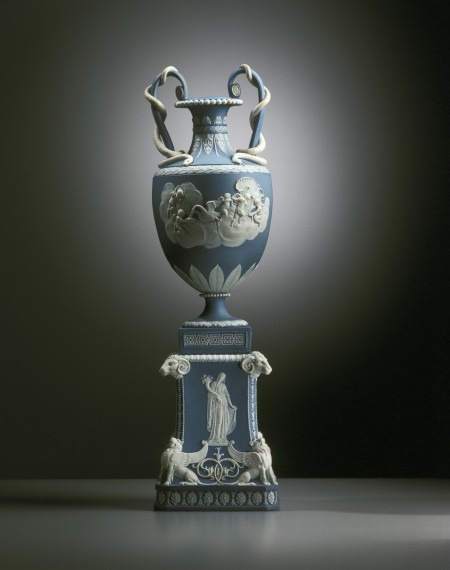
"Wedgwood’s most important contribution to ceramics was jasper which he introduced in 1775. A result of more than 3000 trials in the search for a ceramic material that would best fit the new style, jasper was a dense white stoneware ideal for his decorative objects inspired by the classical art of ancient Greece and Rome. Named after the gemstone of the same name, jasper was easy to mould and decorate and could be stained by metal oxides in many colours. It was blue jasper however, that soon became synonymous with the name Wedgwood."
It would be wonderful to be able to say that Karl Weber won appreciation in his lifetime or shortly after, that his work determined the pattern of excavation around Vesuvius, and that he died a happy man. But none of that is true. … The jealousies and ambitions that raged around the court of Naples and the palace near Herculaneum cannot be underestimated. Whether Weber himself was an important mover in the court controversies, or merely a Swiss pawn in the hands of others more skillful in the intricacies of Spanish-Italian intrigue, it seems hard to determine. He did have friends and those who used his work to strike at other members of the court. On the other hand, he does not appear to me to have been an easy man to work with, not one to pass a pleasant evening with; and he was far from tactful in dealing with the tricky protocol of the court. He was married, contrary to military regulations, at the age of twenty-seven to a Neapolitan woman and member of the noble de Luna family. It was an unwise alliance on several scores: he was brought up on charges of violating regulations by his commanding officer; the Luna family insisted on his paying a marriage settlement (which ruined him financially) without, it appears, putting up a dowry; and the marriage proved dreary for both — which was the reason for the regulation against intermarriage of Swiss and Italian — in that there were no children, and husband and wife spent little time together. ( Anderson )





 COMMENTS
COMMENTS